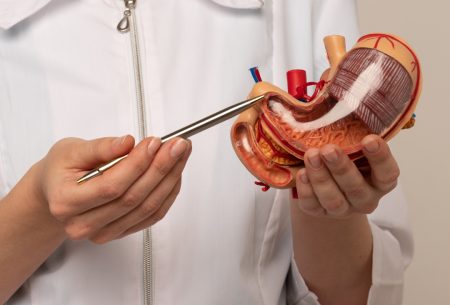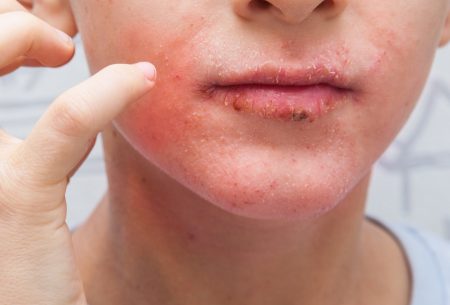What is NAFLD?
Non-alcoholic fatty liver disease (NAFLD) is defined as an excess accumulation of fat in the liver, not as a result of alcohol intake. (1) NAFLD is estimated to affect up to 1 in 5 people in the UK. (2)
According to the NHS, having fatty liver can put one at risk of serious health problems, such as:
- Type 2 diabetes
- High blood pressure and
- Kidney disease
Although obesity can predispose to NAFLD, it has also been reported in lean individuals, emphasizing that genetic and environmental factors also contribute to disease development.
What are the symptoms?
There are not usually any symptoms in the early stages. (1) You probably will not know you have NAFLD unless it’s diagnosed during tests carried out for another reason.
People with more advanced NAFLD may suffer from:
- A dull or aching pain in the top right of the tummy (over the lower right side of the ribs)
- Extreme tiredness
- Unexplained weight loss
- Weakness
How is it diagnosed?
Doctors use liver function tests, liver ultrasound, CT scan or MRI scan to diagnose NAFLD, however some people will have to have biopsy. If detected and managed at an early stage, it’s possible to stop NAFLD getting worse and reduce the amount of fat in your liver. (1)
The gut-liver axis in NAFLD
The term gut–liver axis refers to the bidirectional relationship between the gut and the liver, which involves a complex relationship between the gut microbiome, the immune system, and the gut barrier. (3-5)
The liver communicates with the gut via a release of bile acids and antimicrobial molecules, such as immunoglobulins A (IgA) that help to regulate the gut microbiota and the immune system. This process prevents the overgrowth of pathogenic microbes and keeps the gut barrier intact.
The gut sends nutrients, microbiota byproducts that help to regulate liver glucose and lipid metabolism and recirculates bile acids back to the liver. (3,4)
The liver receives 75% of its blood from the intestines via the portal vein. Dysbiosis and increased intestinal permeability (leaky gut) can lead to the movement of gut bacteria and into the portal vein supplying the liver. As a result, an inflammation cascade is initiated in the liver as it becomes infiltrated by immune cells leading to liver injury. This in turn impairs the bile acid (BA) metabolism and promotes gut dysmotility and systemic inflammation. (3-5)
The science
Evidence suggests that the stage of liver injury correlates closely with the severity of gut dysbiosis. (6) The major drivers of leaky gut include gut inflammation and dysbiosis, which have been linked to:
- Consumption of a high fat Western type diet
- Chronic alcohol consumption
- Prolonged antibiotic usage and
- Immune mediated inflammatory diseases such as Inflammatory bowel disease (IBD). (4)
Some species-specific studies have identified particular bacteria called Akkermansia muciniphila with possible implications for obesity and NAFLD development. A.muciniphila is key increases the thickness of the mucus lining in the gut, hence optimising its barrier function. A.muciniphila was found to correlate positively with a better metabolic health in mice and in human studies with obese and Type 2 Diabetes patients. (7)
Linking it all together
Interestingly, Helicobacter pylori has been identified to be present with a significant frequency in NAFLD patients, indicating a potential link between the presence of this bacteria and the development of fatty liver. (8,9)
There has also been a study suggesting certain mycobiome (fungi) composition can also contribute to NAFLD development. (10)
Bacterial overgrowth in the gut and leaky gut have both been linked to the pathogenesis of NAFLD in humans. (11) It is worth remembering that the composition of the gut microbiome may vary throughout different groups of people and stages of NAFLD, making it difficult to make definitive or causal statements. Large scale, longer-term research is warranted to establish if changes that occur in the bacteria and fungi compositions of the gut are causal or consequent of NAFLD development.
Potential interventions
Probiotics and Prebiotics
There is currently no standardized pharmacological treatment, and the only proven effective therapeutic strategy is lifestyle modification. Manipulation of the gut microbiome composition by probiotics and prebiotics show promise in NAFLD management.
Meta-analysis concluded that probiotic therapies can reduce liver enzymes, total-cholesterol, TNF-α and improve insulin resistance in NAFLD patients. The results from pilot studies seem very promising, however they do have limitations including small sample sizes and a lack of data about the patients’ diets and lifestyles, which may influence the clinical outcomes. More robust randomised clinical trials are necessary to assess the clinical implications of probiotic and prebiotic therapy in NAFLD. (12)
Most commonly researched probiotic in NAFLD is VSL#3 – a mixture of probiotic bacteria including Lactobacilli that has been used in a number of experimental and human studies of NAFLD treatment and shown to improve liver enzymes and the severity of fat infiltration. (13)
Omega-3 fatty acid treatment may also have a prebiotic effect in regulating liver lipid metabolism and inflammation. Recent meta-analyses suggest that Omega3 fatty acids may be useful in the treatment of NAFLD and could have effects on the gut microbiota. It has been shown that Omega 3s increase Akkermansia and other beneficial bacteria. (14)
Diet
Nutrition plays a pivotal role in the management of NAFLD. Studies show that NAFLD patients are more likely to consume high fat, energy-rich foods, saturated and omega-6 fatty acids and sweetened beverages, while not eating enough fresh fruits, green vegetables, fiber, and omega-3 fatty acids. (15)
The Mediterranean diet is associated with a lower prevalence of NAFLD (16).The Mediterranean Diet not only improves liver health on a clinical level, but there are improvements to inflammatory biomarkers, such as cytokines, involved in immune response.
Polyphenol rich foods such as cranberries, flaxseeds, grapes, black tea, fish oil (which are part of the Mediterranean diet), increases the abundance of Akkermansia that keeps the gut lining healthy. These foods contain proanthocyanidins which have prebiotic activity.
Summary
NAFLD is common and it may affect 1 in 5 people in the UK. Since the lack of standardized pharmacological treatment to treat NAFLD, there is an increased interest in nutritional interventions for prevention and treatment of NAFLD. Research relieved the involvement of several components of the gut-liver axis such as microbiota dysbiosis, leaky gut, changes in bile acid metabolism, and reduction in SCFAs in progression of the NAFLD.
Gut and liver optimisation by Mediterranean dietary patterns rich in antioxidant rich plant foods and Omega 3s may offer an efficient approach to prevention and management of NAFLD. Although research is very promising, large trials are needed to establish the specific strains and dosages of probiotics in NAFLD.
Need extra support?
The Gut Health Clinic is here to help you wade through any complexities!
If you would like assistance to further understand NAFLD, or could use some personalised support in your journey, you can click here to book an appointment with me.
References 1-8:
- The NHS at https://www.nhs.uk/conditions/non-alcoholic-fatty-liver-disease/accessed on 30.05.23
- British Liver Trust https://britishlivertrust.org.uk/information-and-support/liver-conditions/non-alcohol-related-fatty-liver-disease/accessed on 30.05.23
- Tripathi A, Debelius J, Brenner DA, Karin M, Loomba R, Schnabl B, et al.. The gut–liver axis and the intersection with the microbiome. Nature Reviews Gastroenterology & Hepatology. [Online] Nature Reviews Gastroenterology & Hepatology; 2018;15(7): 397–411. Available from: doi:10.1038/s41575-018-0011-z
- Milosevic I, Vujovic A, Barac A, Djelic M, Korac M, Radovanovic Spurnic A, et al.. Gut-Liver Axis, Gut Microbiota, and Its Modulation in the Management of Liver Diseases: A Review of the Literature. International Journal of Molecular Sciences. [Online] International Journal of Molecular Sciences; 2019;20(2): 395. Available from: doi:10.3390/ijms20020395
- Manzoor R, Ahmed W, Afify N, Memon M, Yasin M, Memon H, et al.. Trust Your Gut: The Association of Gut Microbiota and Liver Disease. Microorganisms. [Online] Microorganisms; 2022;10(5): 1045. Available from: doi:10.3390/microorganisms10051045
- Fukui H. Role of Gut Dysbiosis in Liver Diseases: What Have We Learned So Far?. Diseases. [Online] Diseases; 2019;7(4): 58. Available from: doi:10.3390/diseases7040058
- Xu, Y.; Wang, N.; Tan, H.-Y.; Li, S.; Zhang, C.; Feng, Y. Function of Akkermansia Muciniphila in Obesity: Interactions with LipidMetabolism, Immune Response and Gut Systems.Front. Microbiol.2020,11, 219.
- Abo-Amer, Y.E.-E.; Sabal, A.; Ahmed, R.; Hasan, N.F.E.; Refaie, R.; Mostafa, S.M.; Mohamed, A.A.; Khalil, M.; Elagawy, W.; Abd-Elsalam, S. Relationship between Helicobacter Pylori Infection and Nonalcoholic Fatty Liver Disease (NAFLD) in a DevelopingCountry: A Cross-Sectional Study.Diabetes Metab. Syndr. Obes.2020,13, 619–625.
References 9-16:
- Wijarnpreecha, K.; Thongprayoon, C.; Panjawatanan, P.; Manatsathit, W.; Jaruvongvanich, V.; Ungprasert, P. Helicobacter Pyloriand Risk of Nonalcoholic Fatty Liver Disease: A Systematic Review and Meta-Analysis.J. Clin. Gastroenterol.2018,52, 386–391.[CrossRef] [PubMed]
- Demir M., Lang S., Hartmann P., Duan Y., Martin A., Miyamoto Y., Bondareva M., Zhang X., Wang Y., Kasper P., Bang C., Roderburg C., Tacke F., Steffen H.M., Goeser T., Kruglov A., Eckmann L., Stärkel P., Fouts D.E., Schnabl B. The fecal mycobiome in non-alcoholic fatty liver disease. J Hepatol. 2021 S0168-8278(21)02238-8.
- Nicoletti, A.; Ponziani, F.R.; Biolato, M.; Valenza, V.; Marrone, G.; Sganga, G.; Gasbarrini, A.; Miele, L.; Grieco, A. IntestinalPermeability in the Pathogenesis of Liver Damage: From Non-Alcoholic Fatty Liver Disease to Liver Transplantation.World J.Gastroenterol.2019,25, 4814–4834.
- Ma Y-Y. Effects of probiotics on nonalcoholic fatty liver disease: A meta-analysis. World Journal of Gastroenterology. [Online] World Journal of Gastroenterology; 2013;19(40): 6911. Available from: doi:10.3748/wjg.v19.i40.6911
- Derosa G, Guasti L, D’Angelo A, Martinotti C, Valentino MC, Di Matteo S, Bruno GM, Maresca AM, Gaudio GV, Maffioli P. Probiotic Therapy With VSL#3® in Patients With NAFLD: A Randomized Clinical Trial. Front Nutr. 2022 May 24;9:846873. doi: 10.3389/fnut.2022.846873. PMID: 35685888; PMCID: PMC9172906.
- Nobili V, Alisi A, Musso G, Scorletti E, Calder PC, Byrne CD. Omega-3 fatty acids: Mechanisms of benefit and therapeutic effects in pediatric and adult NAFLD. Crit Rev Clin Lab Sci. 2016;53(2):106-20.
- Vranešić Bender D, Nutrizio M, Jošić M, Ljubas Kelečić D, Karas I, Premužić M, Domislović V, Rotim C, Krznarić Ž. Nutritional status and nutrition quality in patients with non-alcoholic fatty liver disease. Acta Clin Croat 2017; 56(4): 625-634.
- Sofi, F., Casini, A. Mediterranean diet and non-alcoholic fatty liver disease: New therapeutic option around the corner? World J Gastroenterol. 2014; 20 (23), 7339-7346.












